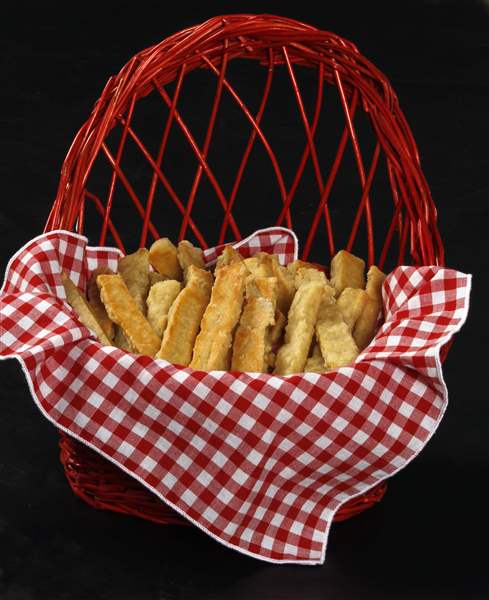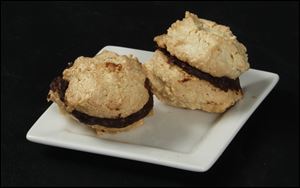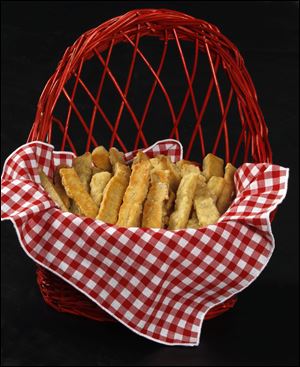
Art of French baking is still alluring after all these years
2/26/2013
French bread sticks.
The Blade/Lori King
Buy This Image
Editor's note: The original version of this article misstated the title of the cookbook. The correct title is "The Art of French Baking."

French cookies.
The one thing I don't need is another cookbook.
At any given time, my bookshelves are weighed down with at least 150 of them. When they grow to be about 200, we give the surplus away.
But there I was, in one of my favorite stores in Chicago, and a cookbook was calling to me. It wasn't even a bookstore, it was a store that sells cool dinnerware and a host of related items, mostly from Europe. It only sells a couple of cookbooks, but one of these was calling.
I've had a lot of experience in this, and usually I can resist. I've even resisted the same book from the same store, when the siren's song was just as strong. But this time, as if by some sort of supernatural source, I was compelled to give in.
The book is The Art of French Baking, by Ginette Mathiot, and it is in fact compiled from two books Mme. Mathiot wrote in the 1930s. Je Sais Cuisiner, (I Know How to Cook) written in 1932 when she was just 25, was a huge best-seller. Six years later, she wrote one of her many follow-ups, Je Sais Faire La Patisserie (I Know How to Make Pastries), specifically focusing on sweet baked goods.
These books sold millions of copies because they did not feature the fanciest recipes or re-creae the experience of eating at a restaurant. They were meant for housewives and husbands wanting to cook traditional French food.
Of course, traditional French food is fabulous, which is why the book appealed to me so strongly. And the recipes in the book were all so easy and made with comparatively few ingredients. So I bought it. Could millions of French cooks be wrong?
As it turns out, non. This is one of those rare books in which you want to try every single recipe — just because they look so good, not in an obsessive, Julie and Julia way.
So I dug in, starting with something that looked like macarons and sort of sounded like macarons, but were instead marzipan cookies. Macarons are those impossibly light, almond meringue cookies filled with delightfully flavored creams that are all the rage in bakeries both here and in France. But that is the problem: They are notoriously difficult to make and are probably best left to professionals. In other words, they are not the sort of easy dish featured in the book.
The marzipan cookies, though, are much the same idea. They are a heavier version of macarons, though not as heavy as actual marzipan candy. They are made from almond flour (blanch your own raw almonds, remove the skins with a quick little snap, and then grind the nuts), sugar, and egg whites. Where macarons are delicate, these are dense and chewy, but just (or nearly) as delicious.

French bread sticks.
For the chocolate cream filling, I used Mme. Mathiot's recipe for ganache, the glossy, all-purpose chocolate topping. But whereas most ganaches are created by stirring cream into melted chocolate, hers uses butter and the rich and slightly tangy creme fraiche. This substitution gives the chocolate a little more body and assertiveness; it is, as they say, magnifique.
Happy with the book already, I decided to make something savory and even easier. One chapter of the book is devoted to crackers, but the French idea of crackers is not the same as ours. As it says in the book, their crackers are "plainer than sweet cookies," and "can be served along with hors d'oeuveres, or with cheese after a meal." In other words, they are more than a cracker, but less than a cookie.
They are also, at least in the case of Savory Sticks, utterly addictive. Nothing more than flour, milk, butter, and salt, they are thin and a bit chewy. The extraordinary flavor and texture comes when the dry ingredients are dumped all at once into the warm liquid ingredients and then, after they are thoroughly stirred together, the dough is allowed to rest for an hour before baking.
I had some creme fraiche left over from making the ganache, so I decided to make creme fraiche cookies. That's maybe not the best reason to make something, but for these particular cookies, any excuse will do.
Ultra-crispy creme fraiche cookies are an excellent example of what this book is all about. They are not something you would find at a patisserie, they are what the average Frenchman would make at home. From start to finish they can be made in 20 minutes, depending on how long it takes your oven to preheat, they only require four ingredients, and they taste delightfully fresh and wholesome. They're irresistible.
The only thing better than making them is eating them. But don't eat too many of them at a time — these things are truly sinful.
I should take my own advice. From now on, I am going to bake my way through this book a little bit at a time.
2 tablespoons all-purpose flour, plus more for dusting
1 generous cup raw almonds
1 cup superfine sugar (see cook's note)
2 egg whites
Grated zest of 1 lemon
½ quantity ganache (see below), optional
Cook's note: If you don't have superfine sugar, simply blend a little more than 1 cup of regular sugar in a blender or food processor for 10 seconds.
Preheat oven to 350° and dust a baking sheet with flour. Blanch almonds in boiling water for 1 minute, drain, and allow to cool until you can touch them. Remove the nut skins and discard; they should pull right off.
Process the almonds with the sugar and egg whites in a food processor, or by hand in a mortar and pestle, to form a semiliquid paste. Add the flour and lemon zest. Arrange small piles of this mixture on the baking sheet. Bake for 30 minutes, until golden. If desired, sandwich in pairs with ganache in the middle.
Yield: 6 servings
Source: The Art of French Baking, by Ginette Mathiot
Ganache
1½ cups chopped semisweet chocolate (about 8 ounces)
½ cup creme fraiche, room temperature
3 tablespoons butter, diced, room temperature
Place the chocolate in a heatproof bowl set over a pan of barely simmering water. Heat gently, stirring occasionally until fully melted and smooth, then remove from the heat. Gradually stir in the creme fraiche and butter, stirring continuously with a wooden spoon or spatula until mixed to a soft cream. Let set for a few hours. Use to decorate or fill cakes while still soft, because the ganache will firm up as it cools.
Use a full recipe to frost cakes or cupcakes, or a half recipe for a filling between cookies (such as marzipan cookies), or a coating for cookies or fruit.
Source: The Art of French Baking, by Ginette Mathiot
Savory Sticks
Scant 1 cup milk
5 tablespoons butter, plus more for greasing
2 cups all-purpose flour, sifted, plus more for dusting
2 teaspoons fine sea salt, divided
In a medium or large saucepan, gently heat the milk and butter until lukewarm and the butter has melted. Remove from the heat and add the flour and 1 teaspoon of salt all at once. Stir vigorously for 2 minutes, or until the dough is very smooth and supple. Let rest for 1 hour at room temperature.
Preheat oven to 400° and grease a baking sheet with butter. Mix the remaining salt with 3 tablespoons of water and set aside. Dust the counter with flour and roll out the dough until ¼ inch thick or thinner. Cut into ½-inch-by-4-inch strips. Place these on the baking sheet. Brush the surfaces with the salty water and bake until golden brown, at least 10-15 minutes.
Yield: 8 servings
Source: The Art of French Baking, by Ginette Mathiot
Creme Fraiche Cookies
Butter, for greasing
½ cup creme fraiche
2/3 cup superfine sugar, see cook's note
1 cup all-purpose flour, sifted
1 teaspoon vanilla extract
Cook's note: If you don't have superfine sugar, simply blend a little more than 2/3 cup of regular sugar in a blender or food processor for 10 seconds.
Preheat the oven to 350° and grease a baking sheet with butter. Mix the creme fraiche, sugar, flour, and vanilla together (a mixer will yield smoother cookies than doing this by hand). Put small piles of the dough onto the prepared sheet, well-spaced apart. Bake for 15-20 minutes, or until the edges of the cookies brown. These cookies keep very well.
Yield: 6 servings
Source: The Art of French Baking, by Ginette Mathiot
Petit Beurre Cookies
7 tablespoons unsalted butter, chilled and diced, plus extra for greasing
2 cups all-purpose flour, sifted, plus extra for dusting
¼ cup superfine sugar (see cook's note)
Pinch of salt
Scant ½ cup heavy cream
Cook's note: If you don't have superfine sugar, simply blend a little more than ¼ cup of regular sugar in a blender or food processor for 10 seconds.
Preheat the oven to 350° and grease a baking sheet with butter. In a bowl, rub the chilled butter into the flour until the mixture resembles bread crumbs, then make a well in the center. Place the sugar, salt, and cream in the well. Combine these by hand with the butter-and-flour mixture, working it just long enough to shape into a smooth ball of dough. Cover the bowl and let the dough rest for 1 hour at room temperature.
Dust the counter with flour and roll out the dough to a thickness of ¼ inch. Cut out rectangles approximately 2-inches-by-4-inches, either using a sharp knife and a ruler, or a fluted rectangular cookie cutter (I used a ravioli cutter). Prick the cookies evenly with a fork and place on the prepared sheet. Bake for 20-25 minutes, until pale brown.
Yield: 6 servings